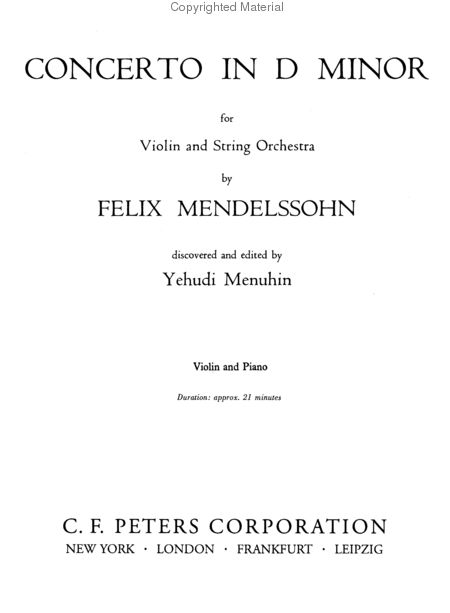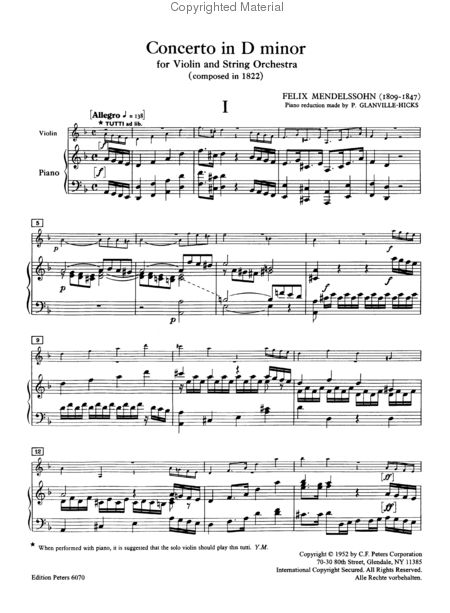
Happy Present Meet
Mendelssohn Violin Concerto in d minor MWV O 3 for Violin and Piano
Duration: 21 minutes
(1822)
(** 일반적으로 많이 찾으시는 협주곡 Op.64가 아닙니다. 다시 한번 확인 후 주문 부탁드립니다.**)
Long before his E minor concerto from 1845, Felix Mendelssohn wrote his first violin concerto: as a 13-year-old in his parents' home in Berlin. There were two sources from which the young Felix drew for this work from 1822: the art of his admired violin teacher Eduard Rietz and the music of Johann Sebastian Bach.
Mendelssohn's early preference for concertos and concert pieces in the key of D minor came from the latter's D minor piano concerto, which he played with great enthusiasm. He wrote three D minor concertos alone between 1820 and 1823, and another - his 2nd piano concerto - in 1837. In all of these works, but especially in the early D minor violin concerto with string orchestra, the “Sturm und Drang” of Bach's D -minor concerto, his motor skills and toccata-like passages leave their mark.
Mendelssohn's early work is also a memorial to the Berlin violinist Eduard Rietz, who died in 1832 at the age of 29. The Rode student was the young Felix's violin teacher and friend, as well as the founder of the Berlin Philharmonic Society and, as concertmaster, the driving force behind the so-called “Sunday music” in the Mendelssohn house. For this Sunday concert series, half of Berlin made a pilgrimage to the banking family's garden house at Leipziger Straße 3 - exactly where the German Federal Council meets today. They didn't move in until 1825, but Rietz probably also played his student Felix's violin concerto there. It survives in two versions: an early two-movement version and the final three-movement version that appears in this edition by Yehudi Menuhin. The first movement with Bach's rhythms is followed by a lyrical Andante full of Mendelssohn's sound magic and a Rondo in Gavotte rhythm in which Rietz was able to shine in the style of Spohr and Rode
펠릭스 멘델스존은 1845년 E단조 협주곡을 쓰기 훨씬 전에 13세 때 베를린에 있는 부모님 집에서 첫 번째 바이올린 협주곡을 썼습니다. 젊은 펠릭스가 1822년부터 이 작품을 위해 그린 두 가지 소스가 있었습니다. 하나는 존경하는 바이올린 교사인 에두아르트 리에츠(Eduard Rietz)의 예술과 요한 세바스티안 바흐(Johann Sebastian Bach)의 음악이었습니다.
D 단조 협주곡과 협주곡에 대한 멘델스존의 초기 선호는 그가 큰 열정으로 연주한 후자의 D 단조 피아노 협주곡에서 비롯되었습니다. 그는 1820년에서 1823년 사이에 3개의 D 단조 협주곡을 썼고, 1837년에 또 다른 하나(그의 두 번째 피아노 협주곡)를 썼습니다. 이 모든 작품에서, 특히 현악 오케스트라와 함께한 초기 D 단조 바이올린 협주곡에서 바흐의 "Sturm und Drang"은 D 단조 협주곡, 그의 운동 기술과 토카타 같은 악절이 눈에 띕니다.
멘델스존의 초기 작품은 1832년 29세의 나이로 세상을 떠난 베를린 바이올리니스트 에두아르트 리츠(Eduard Rietz)를 기리는 작품이기도 합니다. 로드 학생은 젊은 펠릭스의 바이올린 선생이자 친구였을 뿐만 아니라 베를린 필하모닉 협회의 창립자이자 악장으로도 활동했습니다. , 멘델스존 하우스의 소위 "일요일 음악"을 이끄는 원동력입니다. 이번 일요일 콘서트 시리즈를 위해 베를린 시민의 절반은 오늘날 독일 연방 의회가 열리는 라이프치거 슈트라세 3번가에 있는 은행가의 정원 집을 순례했습니다. 그들은 1825년까지 이사하지 않았지만 리츠는 아마도 그의 학생 펠릭스의 바이올린 협주곡도 그곳에서 연주했을 것입니다. 두 가지 버전으로 남아 있습니다. 초기 2악장 버전과 Yehudi Menuhin이 이 버전에 등장하는 마지막 3악장 버전입니다. 바흐의 리듬이 돋보이는 첫 악장은 멘델스존의 사운드 마법이 담긴 서정적인 안단테와 리에츠가 슈포어와 로데 스타일로 빛을 발한 가보트 리듬의 론도가 이어진다.
작곡가 Mendelssohn, Felix (1809-1847)
에디터 Menuhin, Yehudi



Schubert, String Trios in Bb major D 471, D 581 - Urtext (Parts)
Shostakovich Piano Quintet in g minor Op.57
Schubert, String Trios in Bb major D 471, D 581 - Urtext (Parts)
Shostakovich Piano Quintet in g minor Op.57
Elgar Violin Concerto in b minor, Op.61 for Study score
Tchaikovsky Violin Concerto in D Major Op.35 for Violin and Piano
Bach - Busoni Prelude and Fugue in D major BWV 532 arr. for Piano Solo
Mendelssohn Concerto in E minor Op.64 MWV O 14 for Violin and Piano (revised)